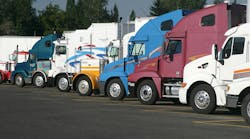HUNTSVILLE, AL. When Navistar announced it was going to meet the Environmental Protection Agency’s 2010 emissions mandate with Advanced EGR technology, many said it couldn’t be done. Some said Navistar could only satisfy the EPA 2010 emissions standard of 0.2 grams of nitrates of oxide (NOx) through the use of emissions credits that allowed its engines to emit 0.5 grams of NOx.
According to Dan Ustian, president & CEO, Navistar not only can meet the 0.2 NOx level without credits, but customers are warming to its distinct engine solution.
“We’re 100% there in terms of our ability to do it,” Dan Ustian, chairman & CEO of Navistar said at a press briefing on Wednesday at the company’s Engine Group facility in Huntsville, AL. “It’s really nothing to do with the technology anymore, it’s [customer] experience. They don’t have any experience with the engine.”
Ramin Younessi, group vice president-product development & strategy, told Fleet Owner that engines meeting the 0.2 limit without credits will be submitted to EPA for certification “within the next few months.”
However, Ustian said that Navistar has a stockpile of credits it intends to use first. He said it could be two years before the 0.2 gram engines are in full production.
“We’re not probably going to get .2 for a couple of years,” he said, adding that the use of “slightly higher pressure” will assist the company in reaching the mandated level. “You won’t denigrate fuel economy, you’ll improve fuel economy, and there will be no more heat.”
When questioned on the reasoning behind delaying production of the engines, Ustian pointed to the “customer experience.” By delaying the switchover, he said, customers will see almost no change in performance or technologies as Navistar slowly steps down to the 0.2 level.
“We’re on our way to .2 like everyone else, but I think we’re doing it in a clever way, and improving fuel economy,” Younessi said. Truck powered by Navistar engines meeting the 0.2 limit are already being tested, he noted.
“The more experience we have developing Advanced EGR, the more comfortable we are,” said Tim Shick, director of business & product.
Younessi mentioned that Navistar sees specific advantages to the Advanced EGR solution going forward. First and foremost he said will be improved fuel economy. Secondly, Navistar is working on a heat recovery system. The company expects it will be able to use the heat generated by the EGR system to produce power for other operations.
“We’re going to use that heat and convert it into electricity or some form of power,” Younessi said.
As the subject switched to the new joint Environmental Protection Agency (EPA) and the National Highway Traffic Safety Administration greenhouse gas and fuel economy proposals, Younessi told Fleet Owner that reaching the new levels should not be a problem for Navistar.
“Back in ’07, we set an internal target to improve the fuel economy of the whole truck 30% [based on a 2007 ProStar with Cummins engine],” he said. “We’re a little more aggressive on the timeline than the greenhouse gas [targets].”
Aerodynamic devices are one area Navistar will explore. Younessi said the company will also unveil a new transmission created in conjunction with Eaton next year “that will further improve fuel economy” as well.




